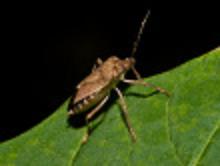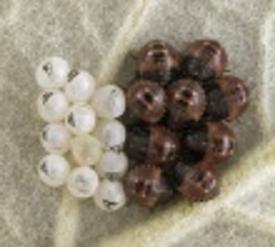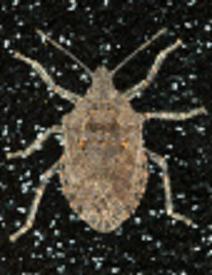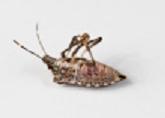|
The Stink Bugs Exposed
While previously classified as a nuisance pest and not officially classified as a tree pest, last year, 2010, the disturbing discovery of hordes of stink bugs accumulating on the trunks of landscape and nursery trees and feeding on the tissue beneath the bark may well lead researchers and “classifiers” to a different decision. Reports of the Brown Marmorated Stink Bug feeding on a wide variety of forest and ornamental trees, as well as plants and vegetables, field and fruit crops may continue to grow and lead to a more aggressive classification of this pest. Homeowners who have favorite plants, trees and bushes where the stink bugs like to congregate may well be in for a horde of unwanted guests. While not officially classified as a “tree pest” this may well be semantics. The stink bug loves fruit. The Stink bug eats fruit. Last year alone the stink bug took a 25% bite out of the apple harvest in Pennsylvania’s highly profitable $69 million apple industry, thereby making the stink bug a pest to fruit growers. Officially or unofficially, if you are growing apple trees for the apples, and stink bugs are eating them instead of you - you have a pest. In Asia, the Brown Marmorated Stink Bug (BMSB) is a major agricultural pest of fruit trees, citrus trees, legumes, soybeans, corn, squash, tomatoes, peppers, and more. Farmers and gardeners agree, the stink bug is a true pest. Most pests gravitate towards one crop or another. Stink bugs are not so picky. They like many different crops. Farmers and fruit growers must be on early monitoring patrol.
Stink bugs came to the United States from Korea or China, probably in an agricultural shipment, in the mid to late 1990’s, and have multiplied uncontrollably in the Mid-Atlantic region, due to the lack of natural predators that keep them in check in Asia. Many state-sponsored stink bug control methods have focused on the release of such natural predators/parasites in the hopes of protecting crops and gardens in the areas where they are released. Calling your local authorities may help? Stink bugs are easily recognizable by the shield on their back. They emit small amounts of a noxious substance from glands under the bodies to deter predators and send signals to other stink bugs. In the garden, stink bugs can wreak havoc on crops as well as generating an unpleasant smell, and in the home, a stink bug invasion can be most unpleasant. Not only do they stink, but some people may have an allergic reaction. Asthmatics are having issues. If smashed they have also been known to leave a mark on furniture or other surfaces that is non-removable. To make matters worse, stink bugs seem to be resistant to common pesticides. Although stink bugs are primarily pests of crop fields, they can be found in meadows, fields, yards, or gardens and especially those with low shrubs. They are most active from spring through fall, but usually become house invaders at the beginning of fall when temperatures begin to drop. They sometimes hibernate on the outside of some south-facing buildings for warmth, but usually over winter in protected areas under dead weeds, stones, in the bark of trees OR IN YOUR HOUSE. Adult BMSB emerge from over wintering (most likely in your house) in Mid May/early June (although warm spring days may bring them out of hiding inside your house earlier). The adult females must feed prior to mating and laying their eggs. The adult female can lay anywhere from 250 – 400 eggs in a lifetime. Egg masses are laid on the undersides of plant leaves in clusters which contain 20-30 pale green or white eggs. The BMSB eggs are round where native stink bugs eggs are barrel-shaped. Adult BMSB have a two year life span. Generally, in most climates there is one generation per year, although in the warmer climates two generations have been noticed yearly.
If aggravated, they have been known to pierce humans. They can cause major damage to gardens and are causing damage to peaches and apples, soybeans and corn, and even some ornamental shrubs and trees. Some of the other trees and plants the BMSB have been enjoying, besides apples and vegetable crops are: Butterfly bush, Peach and Pear trees, Maple trees, Catalpa, Redbud, Yellow wood, Honey locust, Hibiscus, Tulip tree, Crabapples, Paulownia, Black Cherry, Yoshino Cherry, Lilac, Elm, Zelkova, Cleome, Dahlia and Zinnia.
The seasonal buildup of the pests on these trees in your yard may well lead to the migration, when cold weather hits, into your home.
If you have stink bugs in your garden, the first thing you should do is remove weeds, because the bugs can use the weeds as a cover. To deter the bugs from your house, remove weeds and foliage near the house. After you have removed weeds and other foliage which could be used as cover, you can try scattering kaolin clay around the area, or spray your plants with a kaolin clay solution. Stink bugs are not able to lay eggs and feed on plants covered in this harmless mineral clay, which can simply be washed off any vegetables and fruits. If these measures do not work, a number of companies produce organic insecticide soaps which are targeted at stink bugs, or you can use chemical insecticides which are formulated for various stink bug species. Before using insecticides, however, be aware that insecticides are highly toxic and difficult to deal with, and they should only be considered as a last resort.
This is not a do-it-yourself job! There are laws associated with pesticide application. For example, it is illegal to apply pesticides contrary to what the instructions on the label say. Further, it’s illegal if you allow your pesticide to drift onto things for which it’s not intended. It is important to note, as well, that some pesticides are neurotoxins, and improper spraying can be very hazardous to your health. It is always best to hire a trained professional to handle the chemicals if that is your chosen remedial action.
If stink bugs have penetrated your house, the first thing you need to do is to stop the problem from getting any worse. Use caulk to seal the house thoroughly, paying special attention to the areas where stink bugs are crawling through, sealing cracks or openings around utility pipes, chimneys, windows, doors and siding. Repair any holes in door screens. If you use a vacuum to suck up the bugs, DO NOT crush or kill them, because this could attract more stink bugs. The stink bug odor can last as long as six months in your home, which serves to attract other stink bugs and some believe that is why they seem to return to homes which were previously infested. If you are attempting the vacuum method, once you have pulled as many stink bugs out of the house as possible, empty the vacuum canister outside, or throw away the bag. You may need to repeat this process several times if they are in the walls. (Note: There have been reports of contaminated vacuum cleaners having a perpetual smell. So use this treatment plan at your own risk.) Important Note: When mixing chemicals and/or ingredients together, use extreme care. Even common household chemicals, when mixed, can be harmful. Pesticide poisoning is deadly. You could become very ill. There may even be long term effects. There are a number of options which might be used to control stink bugs, although there is no best option to deal with the pests. One important consideration is that many stink bugs are resistant to common pesticides. If you are considering chemical control, consider using the services of a company which specializes in such infestations. Treating your home outside before they have a chance to infiltrate inside. For the DIY’ers - Home methods of exterminating are of the “folk” variety. Some claim to have success. Some not. I have listed them below for your consideration. Happy Hunting! Good luck! CAUTION: Mixing your own chemicals - combos like chlorine bleach and ammonia - can produce toxic gases. When mixing chemicals and/or ingredients together, use extreme care. Pesticide poisoning is deadly. You could become very ill. There may even be long term effects.
• Ammonia diluted with water. Spray on the bugs or trap in bucket filled with the solution. Do not breathe in the ammonia.
• Soapy water! Dawn dish detergent in a spray bottle to spray the bugs on your screens.
• Mr. Clean with Febreze. Said to produce a thirty second kill time.
• To kill in the house, use scrubbing bubbles foam in a can. They die within the foam.
• Cheap hair spray. Spray them as they land on your screen or outside. The sticky spray incapacitates them, they are unable to fly and appear not to be able to let loose of their awful odor. They soon die. Works on roaches, spiders or beetles. • For use outside on plants and/or vegetables: Make an insecticidal soap spray using one percent isopropyl alcohol mixed with two to three tablespoons of mild soap per gallon of water. Wait 20 minutes after the application and rinse the plants with a garden hose to remove any potential leaf burning residue. Reapply as needed. • A mixture of 2 parts rubbing alcohol to 1 part water in a jar or bucket. Nudge them into the bath. The stink bugs will die in about 5 to 10 seconds in that mixture. Unfortunately, spraying them with the mixture seems to have no effect.
• Avon Skin So Soft also keeps the critters away. Rub on your screens and frames and around your doorways. Smells good too. • Cutter Bug Free Backyard Fogger. A spritz directly on one of the bugs, dies within a minute, without releasing it's odor. • Various strong oils, rosemary, lavender, mint, etc. rubbed on all door jams and molding. • Plant mint around your home. Be careful, it smells great – but grows like a weed. Basil and/or Rosemary, as well, will deter most crawling bugs. • Plastic coffee container (2lb). Wash it out, fill it about an inch or two deep with rubbing alcohol OR bleach. One or the other - NOT both at the same time! Do not inhale this solution. This method may be time consuming, flicking the bugs into the solution one by one, they die instantly and are unable to release their odor. Secure with the lid and out with the trash!
• Windex (the kind with ammonia) – sprayed directly on them.
• 1/4 cup lavender castille soap, mixed with water to fill a 32 oz. spray bottle. Castille soap can be found in most health food stores.
• Soak a half pack cigarettes in water to create a spray. Nicotine will kill them. Gentle hint! • Use a bucket of soapy water and gently nudge the bugs into the bucket. They drown and are unable to release their stink.
• Listerine.
• Coat a can with Crisco and fill the can with corn syrup. Again, nudge the critters into the can. The corn syrup captures them and the Crisco prohibits crawling out prior to death.
• Buy a rooster. It is said that roosters love them. So, apparently, do chickens. The kids might get a kick watching the chickens attempting to nab the little airborne pests.
• Apparently some dogs have taken to the stink bug catching activity, as well, but be careful as it has been known to make some dogs sick.
• Interesting side note: Stink Bugs are actually considered a Vietnamese treat — crunchy-fried, like popcorn.
So, what’s being done?
A task force, The Brown Marmorated Stink Bug Working Group, has been formed to study the behavior of the stink bug in hopes of identifying natural control methods.
Natural predators from China, Japan and Korea are being studied for possible importation to control the stink bugs here without harming our native species. Some of these natural predators are a tiny parasitic wasp which attacks the eggs of the stink bug. Also under development are Pheromone traps which are not yet available commercially. Several research groups have joined forces and are providing thousands of dollars towards research projects in an effort to stay ahead of the stink bug invasion.
Researchers are determined to find ways to eradicate the stink bugs. Latest news for 2011: Dinotefuran Currently the insecticide dinotefuran is not permitted for use in orchards. A federal emergency exemption is being sought for its use against the stink bug crop invasion. If this emergency exemption is won, fruit growers in PA, DE, MD, NJ, NC, VA and WV would be permitted to use dinotefuran.
More information on dinotefuran
From Stink Bugs Exposed To Scruggs Tree Home
|
 Eggs are only found outdoors on plants because stink bugs cannot reproduce indoors. They do not nest or procreate indoors. They are only seeking warm places to over-winter.
Eggs are only found outdoors on plants because stink bugs cannot reproduce indoors. They do not nest or procreate indoors. They are only seeking warm places to over-winter. 
